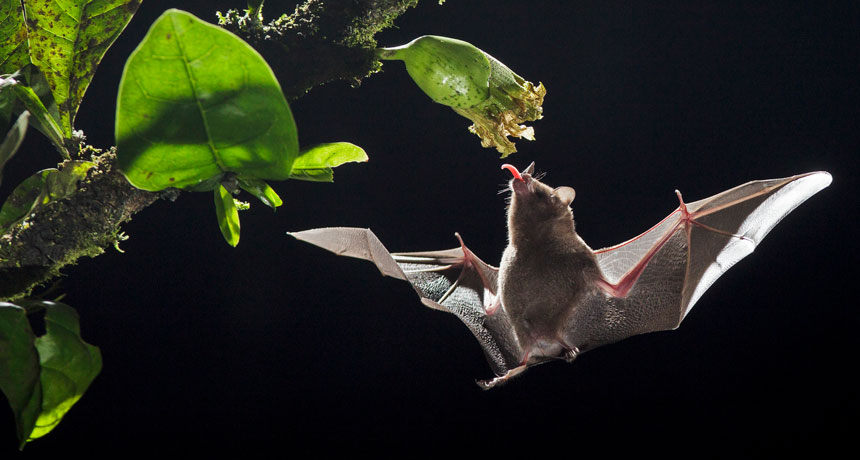How nectar bats fly nowhere

Flying forward is hard enough, but flying nowhere, just hovering, is so much harder. Most bats and birds can manage the feat for only a few frantic seconds.
Hovering means losing a useful aerodynamic shortcut, says aerospace engineer and biologist David Lentink of Stanford University. As a bat or bird flies forward, its body movement sends air flowing around the wings and providing some cheap lift. For animals on the scale of bats and birds, that’s a big help. Without that boost, “you’re going to have to move all the air over your wings by moving it with your wings,” he says. The energy per second you’re consuming to stay in place by flapping your wings back and forth like a hummingbird “is gigantic.”
So how do vertebrates in search of nectar, for whom a lot of energy-sucking hovering is part of life, manage the job? For the first direct measurements of the wingbeat forces that make hovering possible, Lentink’s Ph.D. student Rivers Ingersoll spent three years creating a flight chamber with exquisitely responsive sensors in the floor and ceiling. As a bird or bat hovers inside, the sensors can measure — every 200th of a second — tremors even smaller than a nanometer caused by air from fluttering wings. Once the delicate techno-marvel of an instrument was perfected, the researchers packed it into 11 shipping cases and sent it more than 6,000 kilometers to the wilds of Costa Rica.
“Very difficult,” Ingersoll acknowledges. The Las Cruces Research Station is great for field biology, but it’s nothing like a Stanford engineering lab. Every car turning into the station’s driveway set off the wingbeat sensors. And even the special thick-walled room that became the machine’s second home warmed up enough every day to give the instrument a fever.
Babying the instrument as best he could, Ingersoll made direct measurements for 17 hovering species of hummingbirds and three bats, including Pallas’s long-tongued bats (Glossophaga soricina). “Their up-pointy noses made me think of rhino faces,” he says.
Pallas’s bats specialize in nectar sipping much as hummingbirds do. Comparing wingbeats, bat vs. bird, revealed differences, though. Hummers coupled powerful downstrokes and recovery upstrokes that twist part of the wings almost backward. The twist supplied about a quarter of the energy it takes to keep a bird aloft, the researchers report in the September 26 Science Advances. The two kinds of nectar bats got a little more lift from the upstroke than did a bat that eats fruit instead of strenuously hovering for nectar. Yet even the specialist nectar bats relied mostly on downstrokes: powerful, deeply angled downstrokes of really big wings.
Those bat wings span proportionally more area than hummer wings. So the bats get about the same hovering power per gram of body weight that hummingbirds do. Supersizing can have its own kind of high-tech design elegance.